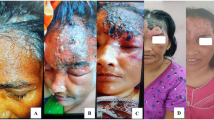Abstract
West Nile virus (WNV) is an RNA flavivirus transmitted through a mosquito vector. In 2018 Nebraska reported 242 cases, the highest incidence of WNV since 2003. This included 119 neuroinvasive cases (49%) and 11 deaths (4.5%) (DHHS 2018). Clinical presentation ranges from uncomplicated symptoms including fever, headache, and myalgias to neuroinvasive disease characterized by meningoencephalitis, flaccid paralysis, and other neurologic manifestations. Neuroinvasive WNV usually occurs in elderly and immunocompromised individuals, and ocular involvement is often not detected until later in the disease course. We describe a case of neuroinvasive WNV presenting with uveomeningitis in a young and otherwise healthy patient.

Similar content being viewed by others
References
Afshar et al (2012) Use of intravitreous bevacizumab to treat macular edema in West Nile virus chorioretinitis. Arch Ophthalmol 130(3)
Anninger W, Lubow M (2004) Visual loss with West Nile virus infection: a wider spectrum of a ‘new’ disease. Clin Infect Dis 38:7. https://doi.org/10.1086/382884
Chan, Limstrom, Tarasewicz, Lin (2006) Ocular features of West Nile virus infection in North America. American Academy of Ophthalmology, Manuscript no. 2005-983.
Garg S, Jampol LM (2005) Systemic and intraocular manifestations of West Nile virus infection. Surv Ophthalmol 50(1):3–13. https://doi.org/10.1016/j.survophthal.2004.10.001
Hasburn et al (2016) West Nile virus retinopathy and associations with long term neurological and neurocognitive sequelae. PLoS One. https://doi.org/10.1371/journal.pone.0148898
Khairallah et al (2004) Chorioretinal involvement in patients with West Nile virus infection. Ophthalmology 111:2065–2070
Khairallah et al (2006) Linear pattern of West Nile virus-associated chorioretinitis is related to retinal nerve fibres organization. Eye 21:952–955
Khairallah M, Yahia SB, Letaief M, Attia S, Kahloun R, Jelliti B, Zaouali S, Messaound R (2007) A prospective evaluation of factors associated with chorioretinitis in patietns with West Nile virus infection. Ocul Immunol Inflamm 15(6):435–439. https://doi.org/10.1080/09273940701798488
Leis AA, Stokic DS (2012) Neuromuscular manifestations of West Nile virus infection. Front Neurol 3. https://doi.org/10.3389/fneur.2012.00037
Narayanaswami, Pushpa et al (2004) West Nile meningitis/encephalitis: P05.109: experience with corticosteroid therapy. Am Acad Neurol 62(7):A404. https://doi.org/00006114-200404001-01013
Pyrogos V, Younus F (2009) High-dose steroids in the management of acute flaccid paralysis due to West Nile virus infection. Scand J Infect Dis 36:6–7
Author information
Authors and Affiliations
Corresponding authors
Ethics declarations
Conflict of interest
The authors declare that they have no conflicts of interest.
Additional information
Publisher’s note
Springer Nature remains neutral with regard to jurisdictional claims in published maps and institutional affiliations.
Rights and permissions
About this article
Cite this article
Rearigh, L., Kedar, S. & Bares, S.H. Uveomeningeal syndrome in a healthy, young male: an unusual presentation of West Nile virus. J. Neurovirol. 26, 281–283 (2020). https://doi.org/10.1007/s13365-019-00808-0
Received:
Revised:
Accepted:
Published:
Issue Date:
DOI: https://doi.org/10.1007/s13365-019-00808-0




